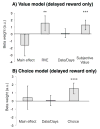Emotional arousal predicts intertemporal choice
- PMID: 26882337
- PMCID: PMC4980249
- DOI: 10.1037/emo0000168
Emotional arousal predicts intertemporal choice
Abstract
People generally prefer immediate rewards to rewards received after a delay, often even when the delayed reward is larger. This phenomenon is known as temporal discounting. It has been suggested that preferences for immediate rewards may be due to their being more concrete than delayed rewards. This concreteness may evoke an enhanced emotional response. Indeed, manipulating the representation of a future reward to make it more concrete has been shown to heighten the reward's subjective emotional intensity, making people more likely to choose it. Here the authors use an objective measure of arousal-pupil dilation-to investigate if emotional arousal mediates the influence of delayed reward concreteness on choice. They recorded pupil dilation responses while participants made choices between immediate and delayed rewards. They manipulated concreteness through time interval framing: delayed rewards were presented either with the date on which they would be received (e.g., "$30, May 3"; DATE condition, more concrete) or in terms of delay to receipt (e.g., "$30, 7 days; DAYS condition, less concrete). Contrary to prior work, participants were not overall more patient in the DATE condition. However, there was individual variability in response to time framing, and this variability was predicted by differences in pupil dilation between conditions. Emotional arousal increased as the subjective value of delayed rewards increased, and predicted choice of the delayed reward on each trial. This study advances our understanding of the role of emotion in temporal discounting. (PsycINFO Database Record
(c) 2016 APA, all rights reserved).
Figures




References
-
- Andreoni J, Sprenger C. Estimating time preferences from convex budgets. American Economic Review. 2012;102:3333–3356.
-
- Brisson J, Mainville M, Mailloux D, Beaulieu C, Serres J, Sirois S. Pupil diameter measurement errors as a function of gaze direction in corneal reflection eyetrackers. Behavioral Research. 2013;45:1322–31. - PubMed
MeSH terms
Grants and funding
LinkOut - more resources
Full Text Sources
Other Literature Sources

